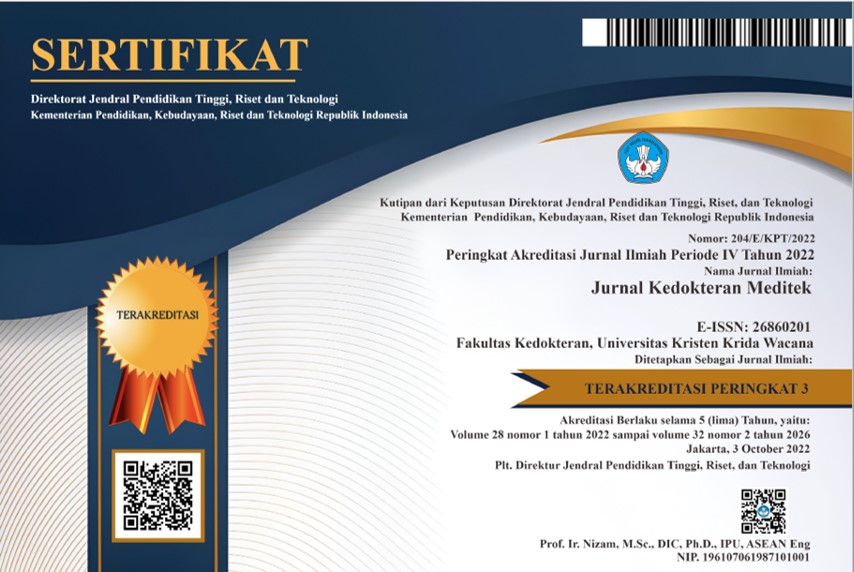Diare Akut pada Anak yang Disebabkan oleh Infeksi
DOI:
https://doi.org/10.36452/jkdoktmeditek.v27i3.2068Keywords:
bakteri, diare, parasit, rehidrasi, virusAbstract
Diare masih menjadi penyebab utama morbiditas dan mortalitas pada anak di negara berkembang. Etiologi diare pada anak didominasi oleh patogen enterik seperti virus, bakteri, dan parasit. Organisme patogen enterik yang cukup sering menjadi penyebab diare adalah rotavirus, E.coli, Shigella spp., Salmonella spp., Vibrio cholerae, dan Entamoeba histolytica. Selama beberapa dekade terakhir, pengetahuan mengenai patogenesis diare akut yang disebabkan oleh infeksi mengalami perkembangan. Tiap organisme menyebabkan gejala diare yang berbeda. Dengan mengetahui gejala dan etiopatogenesis diare akut yang disebabkan oleh infeksi secara tepat, pemberian antibiotik secara berlebihan dapat dicegah sehingga akan mengurangi angka resistensi antibiotik. Tujuan tinjauan pustaka ini adalah untuk memberikan pengetahuan mengenai etiopatogenesis dan tata laksana diare akut yang disebabkan oleh infeksi. Perbaikan hygiene dan sanitasi lingkungan penting untuk mencegah diare akut pada anak. Pemberian cairan rehidrasi oral dengan osmolaritas rendah efektif dalam mengurangi durasi dan frekuensi diare akut dengan dehidrasi ringan-sedang dan mengurangi tingkat kematian yang disebabkan oleh diare akut.
References
World Health Organization (WHO). Treatment of diarrhoea : a manual for physicians and other senior health workers. Switzerland; 2005. [cited 2021 May 20]. Available from: https://apps.who.int/iris/handle/10665/43209
Vu Nguyen T, Le Van P, Le Huy C, Nguyen Gia K, Weintraub A. Etiology and epidemiology of diarrhea in children in Hanoi, Vietnam. Int J Infect Dis. 2006;10(4):298–308.
Guarino A, Ashkenazi S, Gendrel D, Lo Vecchio A, Shamir R, Szajewska H. European society for pediatric gastroenterology, hepatology, and nutrition/european society for pediatric infectious diseases evidence-based guidelines for the management of acute gastroenteritis in children in Europe: Update 2014. JPGN. 2014;59(1):132–52.
Kang G. Viral diarrhea. Int Encycl Public Heal. 2017;7:360–7.
Cajacob NJ, Cohen MB. Update on diarrhea. Pediatr Rev. 2016;37(8):313–22.
Jafari A, Aslani M, Bouzari S. Escherichia coli: a brief review of diarrheagenic pathotypes and their role in diarrheal diseases in Iran. Iran J Microbiol. 2012;4(3):102–17.
Gomes TAT, Elias WP, Scaletsky ICA, Guth BEC, Rodrigues JF, Piazza RMF, et al. Diarrheagenic Escherichia coli. Brazilian J Microbiol. 2016;47S:3–30.
Zhou Y, Zhu X, Hou H, Lu Y, Yu J, Mao L, et al. Characteristics of diarrheagenic Escherichia coli among children under 5 years of age with acute diarrhea: a hospital based study. BMC Infect Dis. 2018;18:63.
World Gastroenterology Organisation (WGO). Acute diarrhea in adults and children: a global perspective. World Gastroenterology Organisation Global Guidelines. Milwaukee; 2012.
Navaneethan U, Giannella RA. Mechanisms of infectious diarrhea. Nat Clin Pract Gastroenterol Hepatol. 2008;5(11):637–47.
Aslam A, Okafor CN. Shigella ( Shigellosis). [Updated 2019 Dec 14]. In: StatPearls [Internet]. Treasure Island (FL): StatPearls Publishing; 2020. [cited 2021 May 20]. Available from: https://www.ncbi.nlm.nih.gov/books/NBK482337/
Harris JB, LaRocque RC, Qadri F, Ryan ET, Calderwood SB. Cholera. Lancet. 2012;379(9835):2466–76.
Satitsri S, Pongkorpsakol P, Srimanote P, Chatsudthipong V. Pathophysiological mechanisms of diarrhea caused by the Vibrio cholerae O1 El Tor variant : an in vivo study in mice. Virulence. 2016;7(7):789–805.
Leibovici-Weissman Y, Neuberger A, Bitterman R, Sinclair D, Salam MA, Paul M. Antimicrobial drugs for treating cholera ( Review ). Cochrane Database Syst Rev. 2014;2014(6):CD008625.
Mada P, Alam M. Clostridium difficile. [Updated 2020 Jun 26]. In: StatPearls [Internet]. Treasure Island (FL): StatPearls Publishing; 2020. [cited 2021 May 20]. Available from: https://www.ncbi.nlm.nih.gov/books/NBK431054/
Ofosu A. Clostridium difficile infection: a review of current and emerging therapies. Ann Gastroenterol. 2016;29(2):147–54.
Mullish BH, Williams HRT. Clostridium difficile infection and antibiotic-associated diarrhoea. Clin Med J R Coll Physicians London. 2018;18(3):237–41.
Herbowo, Firmansyah A. Diare akibat infeksi parasit. Sari Pediatr. 2003;4(4):198–203.
Hodges K, Gill R. Infectious diarrhea: cellular and molecular mechanisms. Gut Microbes. 2010;1(1):4–21.
Sentongo TA. The use of oral rehydration solutions in children and adults. Curr Gastroenterol Rep. 2004;6(4):307–13.
Suh JS, Hahn WH, Cho BS. Recent advances of oral rehydration therapy (ORT). Electrolyte Blood Press. 2010;8(2):82–6.
Dickinson B, Surawicz CM. Infectious Diarrhea: An Overview. Curr Gastroenterol Rep. 2014;16(8):399–404.
Bajait C, Thawani V. Role of zinc in pediatric diarrhea. Indian J Pharmacol. 2011;43(3):232–5.
Berni Canani R, Buccigrossi V, Passariello A. Mechanisms of action of zinc in acute diarrhea. Curr Opin Gastroenterol. 2011;27(1):8–12.
Shinta K, Hartantyo, Wijayahadi N. Pengaruh probiotik pada diare akut: penelitian dengan 3 preparat probiotik. Sari Pediatr. 2011;13(2):89–95.
Guandalini S. Probiotics for prevention and treatment of diarrhea. J Clin Gastroenterol. 2011;45:S149–53.
de Vrese M, Marteau PR. Probiotics and Prebiotics : Effects on Diarrhea. J Nutr. 2007;137(3 Suppl 2):803S-811S.
Casburn-Jones AC, Farthing MJG. Management of infectious diarrhoea. Gut. 2004;53(2):296–305.
Downloads
Published
How to Cite
Issue
Section
License
Copyright (c) 2021 Arvin Leonard Sumadi Jap, Ariani Dewi Widodo

This work is licensed under a Creative Commons Attribution-NonCommercial-ShareAlike 4.0 International License.


















